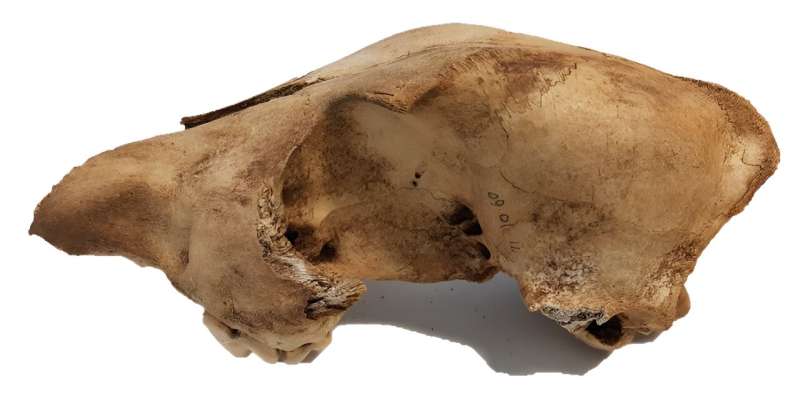This article has been reviewed according to Science X's editorial process and policies. Editors have highlighted the following attributes while ensuring the content's credibility:
fact-checked
peer-reviewed publication
trusted source
proofread
Ancient dingo DNA shows modern dingoes share little ancestry with modern dog breeds

Dingoes arrived in Australia more than 3,000 years ago. Now a new study has compared DNA from fossilized dingo remains dating back 2,746 years with DNA from modern dingoes. The work finds that K'gari dingoes have no domestic dog ancestry—they are pure dingo.
The paper is published in the journal Proceedings of the National Academy of Sciences.
Co-lead author, paleogeneticist Dr. Sally Wasef from QUT's School of Biomedical Sciences, said this dataset provided a rare glimpse into the pre-colonial genetic landscape of dingoes, free from any mixing with modern dog breeds.
"Consequently, they are behaviorally, genetically, and anatomically distinct from domestic dogs," Dr. Wasef said. "Modern-day dingoes' ancestors arrived in Australia more than 3,000 years ago, most likely transported by seafaring people. The samples we analyzed represent the oldest ancient DNA recovered in Australia and indicate broad possibilities of future DNA and conservation work that could be carried out on dingoes and other animals.
"Dingo populations are classified into east and west groups, which were previously thought to have formed during post-colonial human activity. Our findings show, however, that dingoes' population structure was already in place thousands of years ago, and clarify the genetic heritage of dingoes, while highlighting the importance of using ancient DNA for wildlife conservation.
"For example, all K'gari dingoes we analyzed do not have any domestic dog ancestry, proving they preserve their full ancestral heritage. Although we studied only a small number of K'gari dingoes, our findings highlight the importance and usefulness of our pre-colonial ancient genomic data to conserving our unique native animals. Due to poor human behavior that causes some dingoes to become habituated to seeking food from tourists, several problem dingoes have been culled, which is concerning given their small population size."
Co-lead author Dr. Yassine Souilmi, from the University of Adelaide's Australian Centre for Ancient DNA and Environment Institute, remarked that the unique dataset of ancient dingo DNA had helped to uncover crucial details about the ancestry and migration patterns of the modern-day dingo.
"Dingoes had distinct regional populations, split roughly along the Great Dividing Range, long before the European invasion of Australia, and certainly predating the dingo-proof fence," Dr. Souilmi said. "The DNA analysis also showed less interbreeding between dingoes and modern dogs than was previously thought, with our research confirming today's dingoes retain much of their ancestral genetic diversity.
"Dingoes hold significant cultural importance to Aboriginal and Torres Strait Islander peoples and play an essential role in the Australian ecosystem. Understanding their historical population structure helps us preserve the dingo's role in Australian ecology and culture. Dingoes are currently under threat from lethal culling programs, and our research highlights the importance of protecting populations in national parks and beyond."
More information: Souilmi, Yassine et al, Ancient genomes reveal over two thousand years of dingo population structure, Proceedings of the National Academy of Sciences (2024). DOI: 10.1073/pnas.2407584121. www.pnas.org/doi/10.1073/pnas.2407584121
Journal information: Proceedings of the National Academy of Sciences
Provided by Queensland University of Technology





















